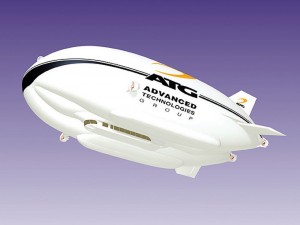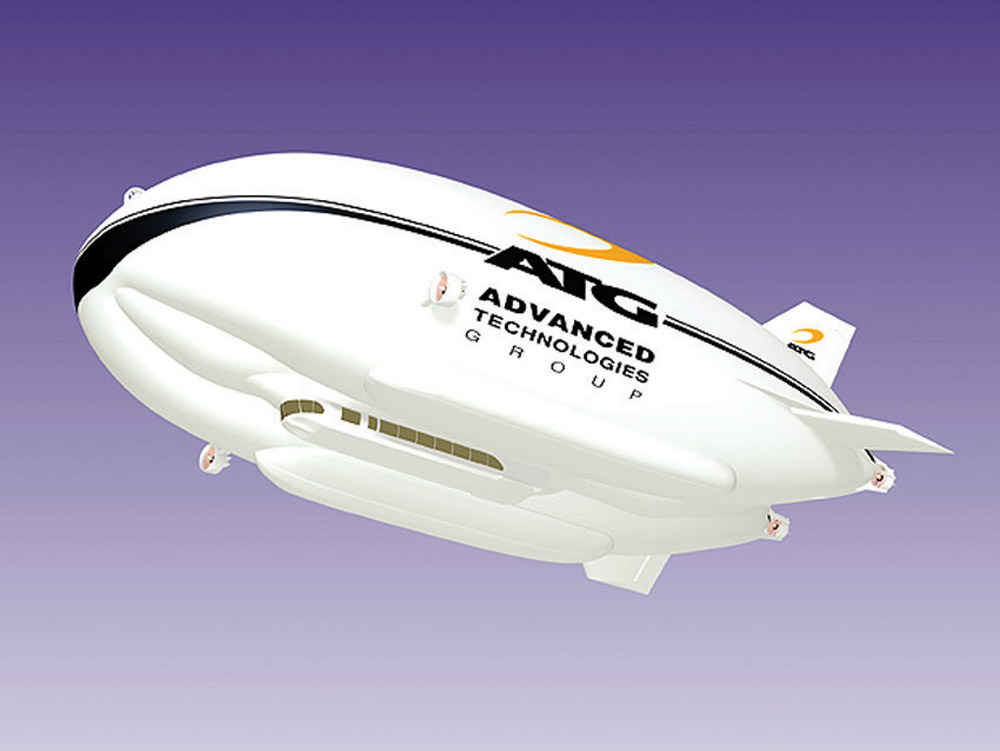By Lance Gurwell

Denver-based Thin Air Group is working with UK-based World SkyCat Ltd. to develop an airship that would fly commuters from Colorado Springs to Denver. It’s hoped that UK-based Advanced Technologies Group, will manufacture the blimps.
A blimp delivers great views of sporting events; Monday Night Football wouldn’t be the same without the services of Goodyear’s zeppelin. Now, a Denver businessman is working with a Great Britain company to put the airship to another use. They want to ferry passengers above the Front Range’s traffic-clogged, road-rage-generating interstate system.
Bart Phlegar, a consultant for Denver-based Thin Air Group, is working with World SkyCat Ltd. to develop an airship that would fly commuters from Colorado Springs to Denver in about 40 minutes, with a round-trip ticket selling for around $23. That’s roughly the same cost as driving a gas-guzzling SUV there and back—and without parking hassles.
Passengers would be dropped at one of the light rail stations near Denver, where they could complete their trip downtown. However, tickets aren’t available just yet. Phlegar initially believed the SkyCat would be test-flown next year, but plans are up in the air.
“Presently, World SkyCat is waiting on a new round of funding,” Phlegar said.
A smaller version, the SkyKitten, has been flying in a test capacity in Great Britain for some time. Its passenger capacity is limited, but it seems to be performing quite well.
World SkyCat was supposed to embark on a “world tour” later this year, to demonstrate the SkyCat’s practicality, but Phlegar said that probably won’t happen until late 2007 now. The cause of the delay is that Advanced Technologies Group, which manufactures the airships, is in “voluntary administration.”
“That’s the UK’s equivalent to Chapter 11 (bankruptcy),” said Phlegar. He said Advanced Technologies Group found it necessary to restructure their debt, which stems from heavy research and development costs, and residual production costs of other projects.
“But World SkyCat is completely solvent,” Phlegar said. “What’s more, Roger Munk, the chairman and founder of ATG, is also a minority shareholder in World SkyCat, along with Michael Stewart, the CEO, and several private holders, including Josh Ramon Lopez Portillo, the son of a former president of Mexico.
“In other words, this thing is funded, whether or not ATG reorganizes, is sold, or becomes defunct. The brain trusts could move right over to World SkyCat seamlessly, and that entity will take over the manufacturing role as well, although they would certainly rather have ATG play that role.”
There are hopes to operate the airships over other Colorado destinations including Fort Collins, Greeley and Black Hawk/Central City, as well as nearby Cheyenne, Wyo. Other states they are looking at include New Mexico and California.
Phlegar said he’s basically working alone on the project in the U.S. While he’s put together detailed reports on the firm’s website, down to the schedules, he has yet to have formal meetings with any of the various entities that would regulate its operation. That would likely be the Federal Aviation Administration, as well as local entities. However, Phlegar said the United Kingdom’s Civil Aviation Authority has given its approval to the concept, and it’s likely the FAA would, too.
Depending on which of several airships is used, up to several hundred passengers could be ferried at one time. Standard aircraft engines would power the airships.
The Goodyear blimp carries about nine people. The blimps Phlegar proposes would carry 175 or more passengers, meaning the helium-filled envelope have to be eight to 10 times larger than the Goodyear blimp. It’s unknown how well a blimp that large would handle in the changeable Colorado weather, which can produce strong winds with little notice.
“There are ongoing concerns about operating the SkyCat at our altitudes, and with our weather, but playing the devil’s advocate, the engineers have no qualms about anything that I have thrown at them, so I trust their judgment,” he said.
Phlegar said three airships would be required to make the Colorado travel schedules practical, and each blimp would cost between $28 and $32 million.
Advertising would help keep the airships profitable.
“Because airships fly at a fairly low altitude, we would be able to reach millions of people every day with advertising on the sides of the SkyCats,” he said. “Advertising would be the major revenue producer, along with ticket sales and food and drink sold aboard the blimps.”
Phlegar said he is moving forward with his plans, which seem primarily aimed at generating publicity about the proposal.
“As we get funding, we’ll put some additional manpower into this, and determine what’s necessary as far as regulations go,” he said.
Will it work?
Michael J. Boyd, president of the Boyd Group, based in Denver, does aviation consulting, research and forecasting for clients nationwide. He reminded that the idea of using a blimp to transport people ended in 1937 with the “Hindenburg.”
“Of course, that blimp was filled with hydrogen, which is explosive, but what do we have a lot of, especially in the winter? Wind,” he said emphatically. “I’m sorry to say it, but this is one of those ideas where I’d say ‘Call me when you have it in operation.'”
He added, tongue-in-cheek, “This would be a great service, especially when the Martians land up in Wyoming. I don’t want to be the one telling kids there’s no Santa Claus, but it won’t work.”
Michael Stewart, CEO of World SkyCat Ltd., said that engineers have carefully analyzed the effects of wind on the airship most likely to be used along the Front Range.
“The SkyCat-20 is designed to withstand gusts of 66 feet per second, which corresponds to approximately 45 mph,” Stewart said. “This would normally be expected once or twice in the service life of the vehicle.”
However, 45-mph wind gusts along the Front Range are not at all that uncommon, and in the mountain passes where some routes are projected, gusts significantly more than 45 mph are possible.
“The vehicle is certified to be able to withstand that load without any loss of structural integrity,” Stewart said. “Also, it’s designed for sea-level air density; at your altitudes, the air is less dense and the margin therefore all the greater.”
Stewart explained that ground maneuverability is controlled via “air cushions.”
“We land and take off on air cushions so we can steer very precisely where we want to go,” he said. “Once at the parking stand, we reverse the air-cushion engines to create very powerful suction forces, which effectively anchor the vehicle to the ground while passengers or cargo are being loaded or unloaded.”
He said that unlike the small conventional blimps, there’s no need for anybody pulling at ropes or for mooring masts.
“We’re entirely autonomous and more maneuverable on the ground than your standard commercial airliner,” he concluded.
The SkyCat-20 is scheduled for first flight in late-2007, with full certification by early- to mid-2008.
“The vehicles will then be available for commercial passenger-carrying service,” he said.
For more information, visit [http://www.thinairgroup.com] and [http://www.atg-airships.com].











